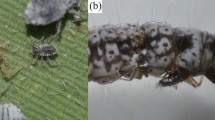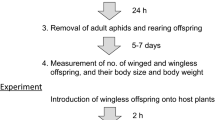Abstract
ALTHOUGH insects are known to defend nests, breeding sites and females1, the defence of feeding sites is less well documented. Other than the defence of egg clutches and nymphs by female treehoppers2 and the existence of a soldier caste in wooly aphids3, territoriality has not been reported in the large insect order Homoptera which includes aphids, scale insects, hoppers, cicadas and whiteflies. As the evolution of territoriality is thought to be directly correlated with competition for resources in short supply4, territorial behaviour should only be exhibited when population densities approach the carrying capacity of the environment. Because parthenogenetic reproduction and the high population growth rates of aphids seem contradictory to the notion of limited resources, aphid territorial behaviour is not expected. I report here on the settling behaviour of the aphid, Pemphigus betae Doane, which forms galls of the leaf blade of narrowleaf cottonwood, Populus angustifolia. We have quantified the existence of a defended micro-territory, the production of a floater population of individuals displaced through competitive interactions, and the differential mortality of residents and floaters which favours the evolution of territorial behaviour.
Similar content being viewed by others
References
Price, P. W. Insect Ecology (Wiley, New York, 1975).
Wood, T. K. Ann. Ent. Soc. Am. 69, 340–344 (1976).
Aoki, S. Kontyû, Tokyo 45, 276–282 (1977).
Brown, J. L. Wilson Bull. 76, 160–169 (1964).
Whitham, T. G. Ecology 59, 1164–1174 (1978).
Whitham, T. G. Am. Nat. (in the press).
Moore, N. W. J. Anim. Ecol. 33, 49–71 (1964).
Alcock, J. Anim. Behav. 23, 889–895 (1975).
Davies, N. B. Anim. Behav. 26, 138–147 (1978).
Parker, G. A. J. theor. Biol. 47, 223–243 (1974).
Stewart, R. E. & Aldrich, J. W. Auk 68, 471–482 (1951).
Hensley, M. M. & Cope, J. B. Auk 68, 483–493 (1951).
Gerking, S. E. Ecology 34, 347–365 (1953).
Healey, M. C. Ecology 48, 377–392 (1967).
Watson, A. Nature 215, 1274–1275 (1967).
Smyth, M. J. Anim. Ecol. 37, 167–183 (1968).
Krebs, J. R. Ecology 52, 2–22 (1971).
Palmer, M. A. Aphids of the Rocky Mountain Region (Hirschfield, Denver, 1952).
Author information
Authors and Affiliations
Rights and permissions
About this article
Cite this article
WHITHAM, T. Territorial behaviour of Pemphigus gall aphids. Nature 279, 324–325 (1979). https://doi.org/10.1038/279324a0
Received:
Accepted:
Issue Date:
DOI: https://doi.org/10.1038/279324a0
- Springer Nature Limited
This article is cited by
-
Spatial heterogeneity of gall formation in relation to chemotype distribution in Thymus vulgaris
Plant Ecology (2019)
-
Morphometric analysis of young petiole galls on the narrow-leaf cottonwood, Populus angustifolia, by the sugarbeet root aphid, Pemphigus betae
Protoplasma (2017)
-
High mean relatedness among communally galling Tamalia aphids revealed by AFLP analysis
Insectes Sociaux (2014)
-
A genetic basis for the manipulation of sink–source relationships by the galling aphid Pemphigus batae
Oecologia (2011)
-
Plant organ abscission and the green island effect caused by gallmidges (Cecidomyiidae) on tropical trees
Arthropod-Plant Interactions (2008)





